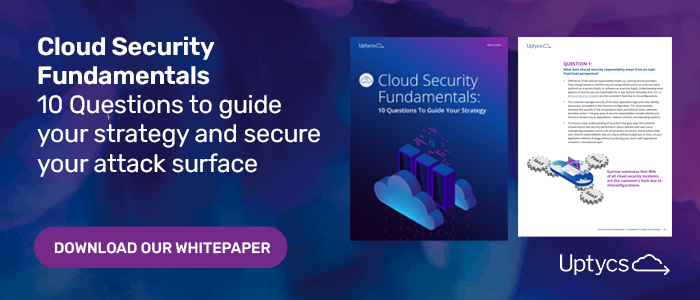Nearly all encompassing and only set to continue evolving, cloud computing has changed the way we live our lives and the course of modern business. With a current estimate of $371.4 billion in 2020 and projected Compounded Annual Growth Rate of 17.5% to amass a market worth of $832.1 billion by 2025, the continued expansion of cloud is guaranteed.
Growing urgency to enable cloud solutions and services across offices, schools, and enterprises prompted by the COVID-19 pandemic accelerated the exigence behind the adoption of cloud, with remaining enterprises and organizations racing to meet competitors, reduction in costs, and operational efficiencies afforded by the assimilation into the agility centered computing landscape.
As vulnerabilities parallel any vector containing sensitive information and infrastructure, understanding the key security considerations unique to adopting a cloud environment is imperative.
Contents:
How Secure Is The Cloud?
What Are The Security Risks Of Cloud Computing?
How To Bolster Security In Cloud Computing
What Are The Main Benefits Of Moving Data To The Cloud?
How Secure Is The Cloud?
Though the opportunity for cybercriminals to exploit an organization face traditional data center environments along with those of cloud computing - at times in ways that overlap, cloud computing introduces another element in that the responsibilities of addressing and mitigating those risks is split between the cloud services provider and the organization.
Establishing a thorough understanding of these relationships must be prioritized as operations move to cloud computing models, and when done successfully provides an organization with the benefits of required compliance and certifications offered by cloud providers to satisfy numerous worldwide criteria.
What Are The Security Risks of Cloud Computing?
Limited Visibility Into Network Operations
As security obligations within the cloud responsibility model are shared between the cloud services provider and the organization, a certain level of visibility into workloads and assets is forfeited during cloud migration. Though the shift in responsibility from the organization to the cloud provider varies in scope and is dependent on the type of service model being used, organizations must be able to monitor their network infrastructure without the use of network-based monitoring and logging.
Malware
As cloud unique cyber-threats emerge when moving sensitive information to an internet-connected cloud environment, organizations must be aware of how their attack landscape may be evolving and the widespread threat malware poses to an organization with cloud infrastructure.
Compliance
As the importance of data privacy has become a growing concern, compliance regulations and industry standards such as GDPR, HIPAA, and PCI DSS have become more stringent than previous iterations. Without the appropriate access controls established across what otherwise could enable limitless large-scale user access, monitoring who has entry to what and the capabilities their access grants them becomes difficult, and poses significant security and compliance risks.
Loss Of Data
With over 60% of organizations citing data leakage as their biggest cloud security concern as reported by the 2020 Cloud Security Report, understanding the risks involved when an organization transfers control of critical data from an internal IT department to a cloud service provider. In the event the cloud service provider experiences a break or attack, an organization will not only lose its data and intellectual property but will also be held responsible for resulting damages.
Poor Due Diligence
Having a concrete understanding of the scope of work required to successfully and move an organization to the cloud is a critical security imperative. Too often than not, organizations that are unaware of the amount of work involved during transition overlook security measures instituted by their cloud service provider and fail to conduct the due diligence necessary to address all potential security gaps.
How To Bolster Security In Cloud Computing
Risk Assessments
Risk assessment frameworks like the NIST Cybersecurity Framework, and ISO 27000 - which includes GDPR, HIPAA, PCI-DSS, CMMC, and FERPA, are frameworks an organization can use to analyze cybersecurity posture and efficacy of current security controls. Identifying potential vulnerabilities through thorough assessment can aid in a consistent and maintained security stance and arm IT teams with the information necessary to direct security decisions.
User Access Controls
Diligent implementation of user access controls is another critical element to ensuring proper cloud security, as cloud is far more easily accessible than an on-premise environment. Zero-trust security, defined as the notion that no person should be implicitly trusted with open network access but only areas and functions critical to their respective role, is a methodology strongly suggested that organizations operate under for maximum cloud security and adoption.
Automation
Avoiding alert fatigue through the implementation of automation and cybersecurity monitoring, threat intelligence collection, and vendor risk assessments is an effective way to lessen the burden on IT departments and prioritize focus on high-priority tasks. As the sophistication of cyberattacks grow each day and can trigger and equally varied and multiplied set of alerts, implementing a learning and response tools prevents the need to manually review all potential threats a network is faced with.
Continuous Monitoring
As opposed to point-in-time assessments, the rapidly evolving and shifting digital landscape of today requires a risk management program lead by continuous monitoring to be most effective in securing an organization. Potentially the most crucial, proper security maintenance, hygiene, and the ability to respond to gaps as they arrive instead of once they are discovered is imperative to a secure cloud infrastructure.
What Are The Main Benefits Of Moving Data To The Cloud?
Though crucial to address the elements of security that foster a comprehensive security stance within an organization’s cloud infrastructure, effective cloud computing can be more secure than traditional networking when done correctly.
Redundancies within the shared responsibility and liability model overlap to enhance data security, cloud storage enables accessibility and the safe restoration of data should an event render an organization’s physical asset repository or machinery inaccessible or obsolete, and cross-enterprise analytics are often offered by cloud service providers - providing consistent security updates and visibility across an organization’s entire attack surface.



%20copy%205.png)




